The Unbearable Lightness of Being, 1988, directed by Philip Kaufman, screenplay by Jean-Claude Carrière and Philip Kaufman, from the novel by Milan Kundera.
The back of the Criterion edition of The Unbearable Lightness of Being refers to the movie as "the screen version of Milan Kundera's 'unfilmable' novel." The Unbearable Lightness of Being isn't the most unfilmable novel ever written, but it's pretty damn impossible to imagine it on film while you're reading it. (What is the most unfilmable novel ever written? Beckett's The Unnamable, with honorable mentions for Gravity's Rainbow, Pale Fire, and of course Ulysses—noting for the record that there are two (!) films of Ulysses).
So what makes a novel unfilmable? Structural complexity and stylistic experimentation don't help, but in the right hands they can be as great on screen as on the page. Novels of ideas aren't easy, but they can also be cinematic; think of A Clockwork Orange. The Unbearable Lightness of Being is a structurally complex, stylistically experimental novel of ideas, but that's not what makes it unfilmable. To give you a sense of the problem, here's the complete second chapter:
If every second of our lives recurs an infinite number of times, we are nailed to eternity as Jesus Christ was nailed to the cross. It is a terrifying prospect. In the world of eternal return the weight of unbearable responsibility lies heavy on every mood we make. That is why Nietzsche called the idea of eternal return the heaviest of burdens (das schwerste Gewicht).
If eternal return is the heaviest of burdens, then our lives can stand out against it in all their splendid lightness.
But is heaviness truly deplorable and lightness splendid?
The heaviest of burdens crushes us, we sink beneath it, it pins us to the ground. But in the love poetry of every age, the woman longs to be weighed down by the man's body. The heaviest of burdens is therefore simultaneously an image of life's most intense fulfillment. The heavier the burden, the closer our lives come to the earth, the more real and truthful they become.
Conversely, the absolute absence of a burden causes man to be lighter than air, to soar into the heights, take leave of the earth and his earthly being, and become only half real, his movements as free as they are insignificant.
What then shall we choose? Weight or lightness?
Parmenides posed this very question in the sixth century before Christ. He saw the world divided into pairs of opposites: light/darkness, fineness/coarseness, warmth/cold, being/nonbeing. One half of the opposition he called positive (light, fineness, warmth, being), the other negative. We might find this division into positive and negative poles childishly simple except for one difficulty: which one is positive, weight or lightness?
Parmenides responded: lightness is positive, weight negative.
Was he correct or not? That is the question. The only certainty is: the lightness/weight opposition is the most mysterious, most ambiguous of all.
So imagine you're Philip Kaufman or Jean-Claude Carrière. How do you film this? It's not completely impossible to include something like this in a film: you could put it in a voiceover, or have a Dan Brown-style "conversation between experts," or have a character give an academic lecture (another of Brown's favorite "techniques"). But such solutions make awkward the kind of discursiveness that seems natural in a novel (which makes Dan Brown's use of them all the more baffling). But as much as I'd love to spend the rest of this essay talking about how terrible The Da Vinci Code is, I'm going to back away from the precipice. Unlike certain pulp authors I could name, Kundera is verbal more than visual, which doesn't make for easy adaptation. You can't film an essay.
Kaufman and Carrière's solution is to cut virtually all of Kundera's philosphical asides, rearrange the events of the novel in chronological order, eliminate the narrator entirely, cut one of the four main characters down to a few minutes of screentime, and in general turn the movie into something that could be mistaken for a conventional love story. So what's left after this radical surgery? Lena Olin, to start.
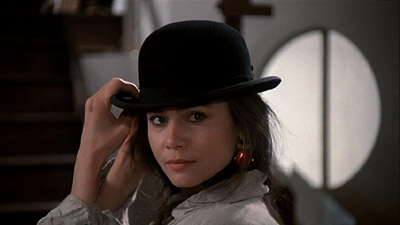
And Juliete Binoche.
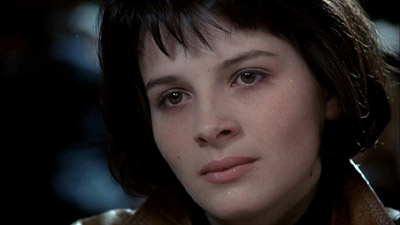
Also, Lena Olin and Juliet Binoche.
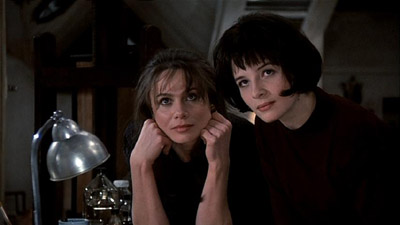
The good news about Kundera's novel is that even after you've turned it into a linear narrative, you still have strong characters and at least one iconic visual (a woman in a bowler). And it doesn't hurt to have two of the most accomplished actresses in the world making their English-language debuts. Lena Olin plays Sabina, one of the main character's (many) mistresses; Binoche is Tereza, the woman he finally settles down with. The main character, Tomas, is played by Daniel Day-Lewis at his most trustworthy and reliable:
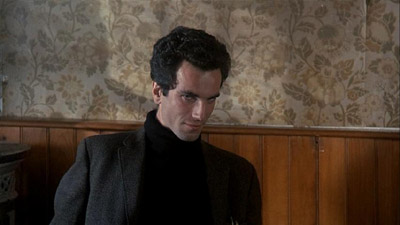
The film, like the novel, follows Tomas from 1968 through fall of 1969, if I have the chronology right. The dates are indistinct except for the central event of the novel: the Soviet invasion of Czechoslovakia in August of 1968. It's worth brushing up on this before watching the movie, because unlike most films that deal with parts of history Americans don't know too well (everything except World War II, in other words), The Unbearable Lightness of Being doesn't spend much time on exposition. And to be honest, it doesn't spend much time on politics either, which is strange for a movie with an invasion at its center. I was talking with my friend Angela about Good Bye Lenin! (which I highly recommend) and she said she really likes "stories where major world-changing events are always just an element in someone's life and not the only one." The Unbearable Lightness of Being is definitely one of those stories, but sometimes I think Kaufman gives short shrift to these events, which are essential to the novel. On the commentary, Carrière says something about how happy he is that the sex scenes in the movie aren't ornamental, as they are in most studio films. He's right; the movie handles eroticism very frankly and realistically. But by focusing on the central love triangle above all, Kaufman risks making world history seem ornamental.
If you know the novel, you'll know it's strange to describe it as a love "triangle." Also missing in this adaptation is the fourth character in Kundera's quartet, Sabina's lover Franz. He still makes an appearance, and Derek de Lint does a fine job playing him, so guilelessly that it's immediately apparent that Sabina is going to break his heart:
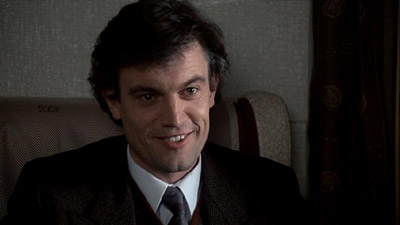
But Franz has very little screen time; the first two-thirds of the film are framed like a traditional love triangle between Tomas, Tereza, and Sabina. In the novel, Franz's overly optimistic leftism and naïveté provides a lightness to balance the weight of the other character's actual experience of communism. But without knowing his politics, or his wife, or seeing his tragicomic end in Cambodia, Franz seems out of place, a minor character that we spend too much time with. The result is, unfortunately, to make Sabina's betrayal seem cruel.
On the other hand, the movie clocks in at 172 minutes as is, so it seems unrealistic to wish more of the novel was there. And even without context, the Soviet invasion of Czechoslovakia is spectacular:

If you think that shot looks a little expensive for an art house movie, you're right. During the actual invasion, students at the Prague film school shot everything they could, and Kaufman uses this stock footage liberally. It's a textbook case of making something amazing on a budget: cutting from Tereza taking a photograph:
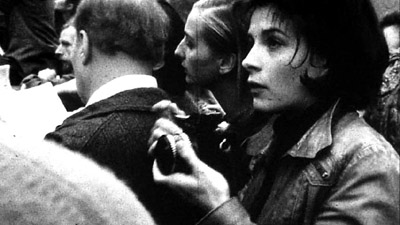
To what she's photographing:
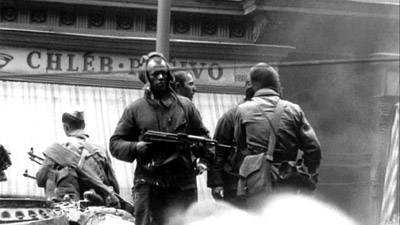
Or cutting from a crowd fleeing tanks:
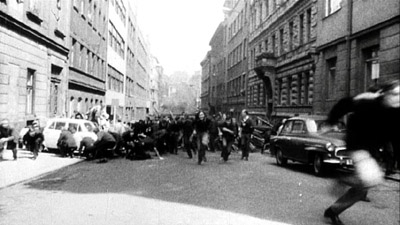
To Tereza and Tomas reacting and running away themselves:
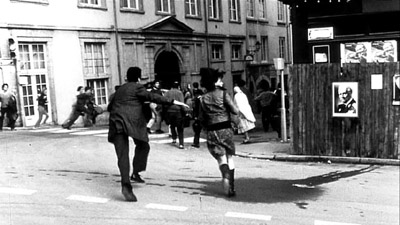
Presented just as stills, it sounds like something Ed Wood would do, but the cuts are very fast and the sequence feels seamless. I didn't realize that any stock footage was being used (and was wondering how on earth they'd staged some of the things I was seeing) until this shot:
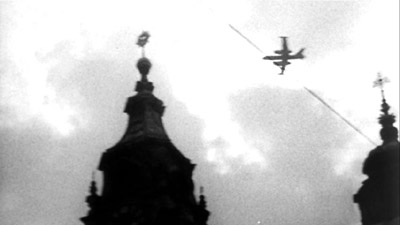
You couldn't fly a vintage Soviet recon plane over St. Vitus Cathedral in 1986, and an elaborate model shot for two seconds of film would have been excessive. As great as this sequence is on its own, in the rest of the film the Soviet invasion is sometimes treated as just another obstacle for Tereza and Tomas to overcome (and Carrière explicitly refers to it as such on the commentary). As the IMDB puts it, "In 1968, a Czech doctor with an active sex life meets a woman who wants monogamy, and then the Soviet invasion further disrupts their lives." That's a lot like the summary of the 1953 version of Titanic I discovered while writing about A Night To Remember: "Their problems soon seem minor when the ship hits an iceberg."
But look: as the excerpt from the novel shows, you couldn't possibly make a movie that was "faithful to the book." The novel's main concerns aren't historical anyway, they're philosophical. And nobody's made a good movie about philosophy yet. Kaufman and Carrière chose to focus on three of the novel's characters, and they got brilliant performances from everyone involved. And the tone is right throughout; "everything is illuminated by the aura of nostalgia," to quote the novel. Evaluated as a character-based love story, the movie succeeds; all three of the characters are wonderfully fleshed out, and by the end, as Roger Ebert noted, you have a sense of the rhythms of their lives. And the ending itself, the one time the film breaks chronology, is perfect, both in tone and execution.
It's hard to criticize the filmmakers for recognizing what works on film and what doesn't. If you're going to make a movie about sex, politics, and philosophy, guess which parts are going to work best on screen? There's one scene that crystallized this for me. Tomas is telling Sabina why he hasn't thrown Tereza out of his apartment (up to this point he's had a no-overnight-guests rule).
If I had two lives, in one life I could invite her to stay at my place, and in the second life I could kick her out. Then I could compare and see which had been the best thing to do. But we only live once. Life's so light. Like an outline we can't ever fill in or correct... make any better. It's frightening.
Tomas's line here is one of the points where the film is closest in its concerns to the novel. Sabina listens to Tomas for a minute and then, mid-sentence, rolls her eyes.
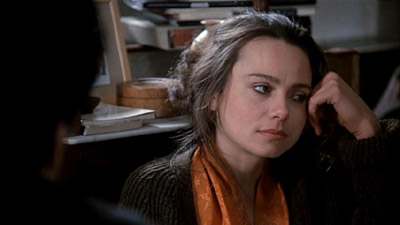
The camera stays on Lena Olin.
Randoms:
- The commentary track is well worth listening to for practical advice about editing. Walter Murch was one of the commenters and for the most part talks about specific techniques he used when cutting the movie, most of them useful and all of them interesting. Just one example: love scenes between Tomas and Sabina feature a lot of mirrors. When you're cutting between a shot in a mirror and the real world, of course, the image reverses itself. It takes the brain about a half-second to parse this, so if you're cutting on an action, you need to have some overlap to cover the cut, or the action doesn't seem continuous. For example, in the two shots below, Tomas is pulling Sabina's robe off her right shoulder in one continuous motion. In this frame, the robe is nearly off her shoulder entirely:
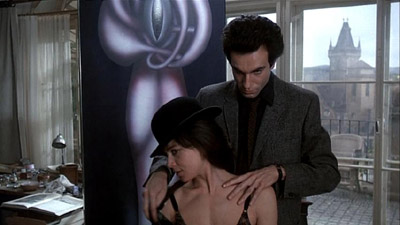
- But in the next frame, after the cut to a mirror image, his hand is back near her collarbone and the action repeats.
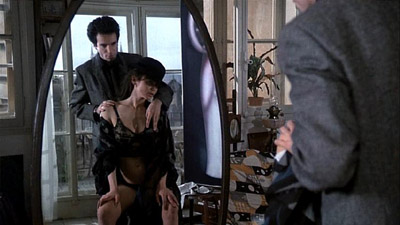
- If Murch had cut to the next frame of motion instead of overlapping, the action would have looked jerky, but as it is, the brain processes it like any other cut on motion, and Tomas's hand moves smoothly. This overlap must have made the sound synchronization a lot of trouble, but Murch was sound editor on The Conversation so I doubt it phased him too much.
- Murch also seems to have a very good sense of the novel's structure. I wonder more generally if editors are more sensitive to structure in novels, since they're used to cutting and restructuring film. In any event, he was the one person on the commentary who mentioned the way the novel retells the key events in different ways and from different characters' perspectives. And he seems to have had a great deal of creative influence. Take the scene where Tereza, angry at Tomas, sleeps with a patron of the bar where she's working. Kaufman shot coverage of both Tereza and her lover; it was Murch who decided to cut the scene using only shots where her lover's face is obscured, to give a sense of what Tereza thinks anonymous sex must be like for her husband. I don't know if this kind of influence is typical but I suspect it isn't.
- At the risk of turning this section into the Walter Murch hour, I should note that he has one other piece of advice for editors: never visit the set. Murch edited Apocalypse Now, and I guess anybody who could stay off that set did. But he has another reason to recommend this. If you see the difficulties involved in getting a particular shot to work, you may prize it more highly than you should; if it takes all day to get the light just right, you might not notice that the result is boring. By the same token, if you know what footage is just people goofing around, you might assume nothing in it is good and miss something great to use. The editor is the only person who can provide a new perspective that late in the creative process, and it's good to have that. However, I doubt Murch was able to take his own advice; the last scenes with Sabina were shot at his house.
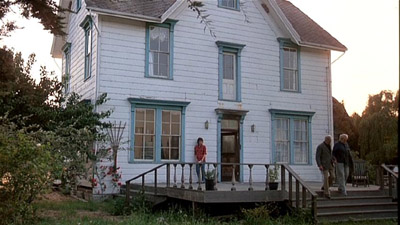
- And the old man walking down the front stairs is Niven Busch, who was a co-writer on the screenplay for The Postman Always Rings Twice and the novel Duel in the Sun. What's he doing in a minor role in this movie? Your guess is as good as mine.
- Speaking of minor roles, the engineer who Tereza sleeps with during her one experiment in infidelity is played by Stellan Skarsgård, who had already mastered the creepiness that would serve him so well in Insomnia.
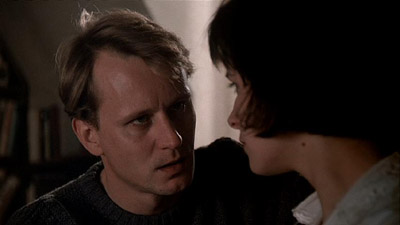
- Not all of the destruction in the Soviet invasion sequence is from stock footage. The production rented a few vintage Soviet tanks from a French general who collected them. I don't know the model of tank, but the plane flying over St. Vitus appears to be a YAK25-RV, a high-altitude recon craft. What it's doing at low altitude over Prague I don't know, but it's the only plane that has that wing shape. (Yes, I'm obsessive enough to try to ID the plane).
- The shot below seemed very familiar to me but I can't remember what it reminded me of.

- I'm thinking specifically of the photos on the wall on either side of the head of the man at the desk. I want to say it's from 8½ or Harold and Maude, not that those two are particularly linked anywhere but my troubled mind. Or The 400 Blows?
- Kaufman tells a great story about Stanley Kubrick on the commentary. There's a scene in the middle of the film where Sabina poses nude for Tereza to photograph and vice-versa. It is, as you would expect, pretty remarkable. Kubrick apparently complimented Kaufman on the film in general, and that sequence in particular. Because he was impressed by the vintage Praktica LTL camera that Tereza uses to photograph. Only Kubrick would see something like this:
Update: I figured it out; it's from Harold and Maude; but it isn't quite the way I remembered it. See the comments for details.
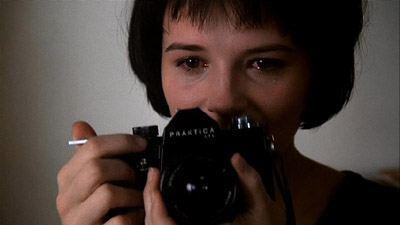
- and find his eye irresistibly drawn to the camera. (By the way, the camera isn't just vintage, but anachronistic; the Praktica LTL didn't start production until December 1970—and yes, I'm just the kind of dork who would try to answer Kubrick's question—but I sure wasn't thinking about it while I was watching the movie).
- Worst pun you could make when writing about a Kundera adaptation that, despite being unfaithful to the novel, is still a very good film: "C'est magnifique, mais ce n'est pas Kundera!" Thank you, thank you, I'm here all week.


19 comments:
Matthew,
Capital job as usual on discussing the unbearable importance of Criterion's picks. I still haven't seen this one yet (I'll always be indebted to Kaufman for creating Indiana Jones, but everything else I've seen that he's been involved with save The Right Stuff has left a mediocre taste in my mouth), but it looks like I'll have to remedy that soon. I must reiterate, as a number of others have already said here, that you're doing a great job on this site explaining and identifying what's noteworthy about each of these films, giving a good argument (although I don't think this is neccessarily your intention) for why it should be in the Collection. Heck, you're the man who pointed out the virtues of that zany item Fishing With John (which I would not otherwise have known existed), so you're definitely mining some gems out of all this rock.
Interesting about the stock footage. It was surely a Sven Nykvist problem more than anyone else's, but do either of the commentaries delve into techniques used to make things "match up" correctly (film stock, lighting, etc.)? It's probably a less complicated problem than it seems to this non-film student (and the sequence appears to be b/w), but I've been fascinated by that sort of trickery ever since Citizen Kane, and always curious when a film chooses to use such tricks extensively. I imagine the rumored (perhaps just wished-for?) Criterion issue of Stuart Cooper's Overlord will probably give this concept a run for its money...
"Nobody's made a good movie about philosophy yet"? Curious what you thought about everyone's favorite polarizing can o' worms, Waking Life. That's the most explicit example I can think of; on a purely subjective level, though, I'd say everything from 2001 to Bergman's Winter Light to freakin' Crimes And Misdemeanors were, if perhaps not explicitly "about philosophy", heavily dependent on philosophical ideas or debates for their impact, and all the better for it. And, of course, Jim Jarmusch asks, "Why am I here?" in Fishing With John. Hardy-har.
Finally, pleasepleaseplease write more of these. I know you're methodical, as such a project as this demands, but I stop here every week at least, eagerly hoping a new exegesis is up, usually to have my dreams crushed. Must I truly wait a decade or more before I get to see you write "what were they thinking...?" about The Life Aquatic With Steve Zissou? La vie, il est trop court.
- Matt (hey, good name, that) Andrysiak
And, yes, okay, Kaufman didn't technically create Indiana Jones, but where would he have been without an adventure to star in, preferably of Biblical proportions? Gimme a break, I've been drinking.
-Matt
Matt,
Glad you're enjoying it. I have every intention of doing these as frequently as possible—the last few months have been kind of nuts, though. If I ever sell a script and am writing full time I'll be more reliable, promise. Right now, though, this project (basically educational) sometimes comes after other writing projects.
To answer your specific question, the matching footage was shot in 35mm color, but then three 16mm negatives were made directly from the workprint (i.e., not from the original camera negative), one in color, and two in black and white, one processed for high contrast and the other processed for low contrast. Whichever negative was closest to the footage it was being matched with was then blown back into 35mm, with the degradation at every step making it look like it had been shot on 16mm in the 60s (the film was then scratched, presumably Citizen Kane style). (Another practial thing that Walter Murch talks about on his part of the commentary). I didn't use any stills from it, but parts of the invasion are shot in color, with that blown-out color look that the Zapruder film has. It's really a great sequence. (I don't know Overlord but on my current schedule I look forward to seeing it sometime around 2020, ha ha).
Waking Life—I thought it looked beautiful, and I'm looking forward to seeing A Scanner Darkly for the same reason—I like rotoscoping. I thought some of the scenes in Waking Life were really interesting and beautiful; (the pinball machine sequence, for instance) but I thought some other parts of it were like being cornered at a party freshman year of college by someone who'd just read Albert Camus for the first time and was dying to talk about it (and for the record, I like Camus). I think 2001 is nominally philosophical but I think it's more visually interesting than a movie that really dealt with the philosophical aspects of Kundera's novel could possibly be. Put it another way: how would you film The Stranger? Could you express everything going on in that book without it being unspeakably boring? My money's on no.
Oh, and just so you don't have to wait: "What were they thinking about The Life Aquatic with Steve Zissou? Wes Anderson with Owen Wilson? Genius. Noah Baumbach on his own? Genius. Anderson and Baumbach? Not so great.
That still with a man at the desk looks familiar to me, too. Of the three possibilities you mention, I'd say maybe Harold and Maude. But then, it also reminds of the scene with Keanu Reeve's character's father in My Own Private Idaho.
I don't understand the Kundera pun at the end. I'm just slow this morning, but it's got me curious--can you explain?
I think you're right that there's never been a good film about philosophy--I don't know of any films that are truly about philosophy. E.g., you quote a bit in that novel about Nietzsche. There's never been a good film about Nietzsche. You could read Hitchcock's Rope that way, but you'd have to be a really lousy reader of Nietzsche to do it. (Rope is perhaps a good version of Dostoyevsky, at best.)
Matt's examples are the only kind of philosophy films there are: "philosophical" in the very general sense of interested in ideas, and usually of the "big-idea" variety. But such films usually do not draw on actual philosophers, and often don't deal with truly philosophical topics; they play with themes that can evoke philosophical questions, but this is not the same thing as being "about philosophy." In most cases, "philosophical" movies betray a pleasure in the pretense of depth, and a deep-seated fear of actual thinking (i.e., bong-talk syndrome).
That's not to say there isn't serious philosophical merit to some aspects of such films. Waking Life's running theme of not being able to come up with a good way to tell whether you're dreaming is a nice accompaniment to Descartes. Being John Malkovitch is a wonderful example of issues of the nature of identity and the self (namely, what is it to be someone over and above having all of their experiences?) Woody Allen wants so badly to be philosophical, yet oddly his seem to fail more than most at hitting actual philosophical themes. Which isn't to say their not serious, interesting, and often well treated themes, but they're more religious than philosophical (Love and Death). My favorite in the philosophical but not really philosophy genre is Python's Meaning of Life.
By the way, I think Life Aquatic is getting a bad rap. I've thought this from day one and I'm sticking to my guns. My verdict is that the last three are very much on par: generally the same flaws and generally the same virtues. (Bottle Rocket, to my mind, stands out as his best, precisely because it avoids the lack of coherence and excesses of the followups.) Anyway. I think it's gotten an unfair treatment for the very simple reason that Rushmore was not nearly as good as the Ministry of Information declared--consequently his more recent efforts have to be slagged to prop Rushmore's reputation. They're all really great, and very imperfect, films.
Oh, and did you know Luchino Visconti did a version of The Stranger? I haven't seen it, since I can't find it anywhere.
P.S. I have to retract my claim that nobody's done a good movie about Nietzsche. Groundhog Day really is a pretty good encapsulation of the Eternal Recurrence.
Yan,
Haven't seen My Own Private Idaho, so right now smart money's on Harold and Maud.
The pun: Pierre Bosquet, observing the Charge of the Light Brigade said, "C'est magnifique, mais ce n'est pas la guerre." ("It is magnificent, but it is not war.") Wikipedia says he was prompted by the "futility of the action and its reckless bravery." I think the same could be said about anyone trying to capture Kundera's writing on film—with the emphasis on the fact that the movie version is, in its non-Kundera-way, magnificent. Like I said, it was a bad pun.
I think your observations about philosophical films are correct—my own favorite film of that type is Andrei Rublev, with a bullet. I think you're wrong about Groundhog Day, though. Cause the point of the eternal return is not that you can keep retrying your day again and again until you get it right, but that you get to make your choice once and then have to live with the same action and results again and again forever, quite the opposite of Bill Murray's predicament. Eternal return would make things like driving the car down the railroad track or into the quarry infinitely more stupid than they are in our world or in Bill Murray's. Of course, I guess that the other characters in the movie were experiencing eternal return, except when they were interacting with Murray.
The Life Aquatic, for me, just didn't have the human interest that Rushmore or The Royal Tennenbaums did; Rushmore had Bill Murray's performance, which I thought was magnificent, and interesting class things going on with Max Fischer. And at its heart it's a love story and a sad one, w/r/t Max, Blume, and Rosemary Cross. The Royal Tennenbaums had that wonderful moment between Chas and Royal where Chas tells his dad he's had a really rough year; I thought that was the best thing Ben Stiller ever did. There wasn't anything in The Life Aquatic that spoke to me that way (this said, I only saw it once, in the theater). I do agree that Bottle Rocket is his best movie, though.
I'd heard there was a movie of The Stranger, but haven't seen it—it seems to me that if you just filmed everything that happened in the novel, you'd have a terrible movie, since the whole point is the narrator's growing detachment from his own fate, and it's conveyed mostly through narration and tone. Like the funeral scene at the beginning; if you were watching it happen without the privilege of knowing how the narrator feels, it could play as tragic. Perhaps it's voiceover heavy, which would suck. Anyway, let me know if you ever track it down, I'd love to see it.
No wonder I missed the pun--didn't know the quote. It's good that you haven't seen My Own Private Idaho. It's in the Collection, and it will be quite an experience to see it fresh.
I don't remember Groundhog Day well enough. I just had in mind the look of horror that started to appear on Murray's face when he'd hear Cher's voice on the radio each morning. That seemed to fit the theme of: would you be happy to live your life over in exactly the same way endlessly? While the analogy isn't exact since he can break the loop, it may still be thematically correct. I think this departure from the analogy to ER (when he replaces apathy with action) underlines the lesson of ER: that one ought to live in such a way that you'd be happy to repeat your life eternally. But I'm going on a very dim memory of the plot, so grain of salt, etc.
I guess I can understand how people might find the human interest of Life Aquatic too subdued or lacking. It's a very candycoated film. But then, I think this is a dominant characteristic of all of his movies. Anderson skeptics and haters claim, ridiculously, that his films are ironic. If anything they're overly sentimental. If there's a tad more candy coating to this one, I still think at heart it's the same kind of film--indeed, pretty much the same film. I found it as moving as Tennenbaums (Rushmore's more juvenile romanticism leaves me laughing but cold). Wilson's character's failed attempts to get away with calling Murray his father are pretty moving--and I was surprised at how shaken I was by his character's death.
It wasn't until I saw Life Aquatic that it really completely hit me just how deeply melancholic and sad Anderson's movies are. I realized that was a part of his films, but by the third one I was convinced that comedy is the smaller part of what they're about.
I'll keep looking for the Stranger. Visconti's a great director, and it has both Marcello Mastrianni and Anna Karina, so I can't possibly die without seeing it. I suspect you're right though. It's a hard novel to film. I think it does work more by tone than narration (though the narrator's tone is key to the overall mood), so it's not entirely impossible. The Cure's musical interpretation captures some of the tone--though perhaps too dark and aggressive, it misses the Mersault's apathy perhaps.
Yan,
Yeah, I'm looking forward to My Own Private Idaho if for no other reason than that I always get a kick out of Udo Kier.
Kundera writes about the Eternal Return that it would make atrocities (the example he gives is the French Revolution) unbearable. One Robespierre must ultimately leave the stage forever, but an eternity of them... In that sense, I suppose Cher and the wacky morning DJs do work with that idea—you're right.
All Anderson's films have that tone of sadness—he's the closest thing to Salinger on film, I think (look at Anthony's conversation with his sister in Bottle Rocket, for instance, a straight crib of Phoebe and Holden Caulfield). And he's got all of Holden's anger at having to grow up, and the same search for fathers. I never really thought of them as comedies, more like tragedies with jokes. But Rushmore isn't too far off in the list, so I look forward to discussing him further then. I'll have to see Life Acquatic again before I make up my mind about it one way or the other.
"Killing An Arab"; you're right that the tone is a little too agressive. Also, try to imagine Mersault singing about anything. Now there's a million dollar broadway idea...
I am completely sold on The Stranger: The Musical.
Good point about Salinger and Wes Anderson. The big NYC family full of precocious children in Tenenbaums has got to be inspired by/cribbed from Salinger's Glass family stories. And although it's clearly from Cousteau, I like to think of the red caps in Life Aquatic as a variation on Holden's orange hunting hat. It's the no-phonies club Holden would have formed, if he could find anyone he'd actually be willing to let in.
Oh boy, are you going to enjoy Udo in My Own Private Idaho. He's fantastic in it. Though he has tough competition in the Dutchboy scene. (You'll find out.)
Looking forward to it!
Matthew,
The shot of the man with the two photos behind him reminds me of one or two scenes in Warren Beatty's Reds. Maybe I'm taking the mention of the two photos too literally, but maybe not. Have you seen it?
Excellent writing about the film! I had a strange reaction to The Unbearable Lightness of Being when I first saw it on the Criterion edition. I remember loving the film, but being very aware that the things I loved about the film were the perfect little moments of performance, especially by Juliette Binoche who I think did brilliantly in her part, that seemed totally natural to the film. I've never read Kundera's novel, but I was left with the impression just from seeing the film that I'd seen the plot but that I would get a somewhat different experience from reading the novel. Not better or worse, but different. I don't know if this makes any sense, but I think at the very least the film has done its job in making me extremely interested in tracking down a copy of Kundera's novel, rather than making me feel as if I don't need to because I've seen all the important stuff in the film adaptation.
At the same time I think only reading the novel would deprive an audience of the beautiful performances, so in a strange way (and of course I'm saying this without having read the book yet!) it feels like they might complement each other rather than being in competition with, or superceding the other.
About Nietzsche and Groundhog Day. Perhaps an even better film to watch about this is the short film from 1990 called 12.01 (not the 1993 TV movie 12:01, which is the 'happy ending' version, I guess!)
http://www.imdb.com/title/tt0098962/
This short has Kurtwood Smith (perhaps best known for his role as Clarence Boddicker in Robocop) in the Bill Murray situation, where he is the only person aware of the, lunch hour this time, repeating. It is much darker than Groundhog Day - after all, how much can you do in an hour? Especially when you have to have prescribed conversations with people that takes up valuable minutes!
It runs the gamut of all possible situations from falling in love with the girl at the park, to desperately trying to find a scientist who can stop the effect, to commiting suicide and then beyond to uselessly screaming in the street for the hour to the eventual sitting on the kerb, spirit broken and unable to find release.
Christopher,
I've seen Reds, but remember virtually none of it. But I figured this one out—it is from Harold and Maud, but it's not one shot, it's a series of them. We see a military officer, then a psychiatrist, then a priest, all framed that way. Each has one picture behind their desk, first of Nixon, then of Freud, then of the Pope. The pictures are in the same positions as in The Unbearable Lightness of Being, but they alternate from right to left and back. You can see a German dubbed version of the sequence (with the aspect ratio set incorrectly) here:
http://www.youtube.com/watch?v=EdTcwgKA29s.
Sorry to have sent people on a wild goose chase; my visual memory is, shall we say, unreliable.
Colinr,
Thanks--glad you enjoyed it. You're right; the novel and film complement each other. They're not really playing for the same stakes.
Kurtwood Smith is very, very good in Robocop, I think. Is 12:01 available on DVD? Wasn't there some sort of lawsuit about 12:01 and Groundhog Day?
The 1993 TV movie with Helen Slater has just come out on DVD, but I'm not sure whether the 1990 Kurtwood Smith short has ever been released.
I could see why they might have filed a lawsuit. The premises are very similar, but strangely they all take different enough approaches to their subject to make seeing all three worthwhile. The short film is tragic, Groundhog Day is of course a romantic comedy and the TV movie 12:01 is more of a romantic thriller (that sounds like it works much better than the recent Sandra Bullock Premonition film!)
Colinr,
Well, I've always loved Groundhog Day. I'll netflix the TV movie and give it a look—thanks for the tip!
Though I'm a few years late I'd like to complement your analysis of the film. It's thorough and remarkable. There's only one aspect of it I might disagree with to any extent.
I've never thought of Kaufman's treatment of the Soviet invasion as ornamental but instead as strictly metaphorical. He's distilled the story down as you note to the essential triangle with the emphasis squarely on Tomas and his view of life/sex. Because of this, I see the Soviet presence (including the invasion) this way:
the prelude is Tomas before he meets Tereza. He's free, almost giddy in his self-assurance that his view of life is the only logical one (or at least the only one that will ever work for him). This idea mirrors the way Kaufman depicts the people of Prague and their almost dismissive attitude toward the Soviet 'barbarians' in their midst. They're almost smug in their belief that they are on a path that can't be reversed.
The invasion itself represents Tereza entering Tomas' life and turning it upside down, sending him reeling in a direction he was sure he'd never go.
The aftermath of the invasion reflects the new reality of Tomas' personal life. It's a life, sure, and within that life there is happiness to be found certainly. But his relationship with Tereza is still a form of bondage to him. It's as though he's being held down by forces he has no control over just as the Czech's now have their freedom hogtied by their Soviet overlords. If he didn't feel this way somewhere in his libertine soul he wouldn't continue to seek out the old hedonistic pleasures. He's trying to circumvent the strictures placed on him just as surely as the Czech's who flee to other places are trying to find freedom from domination in other lands. Sabina flees to Switzerland and then America and finds some measure of freedom there, just as Tomas finds some measure of freedom in his occasional trysts, yet there's something not entirely right about it. They're both seeking a return to the Prague spring and the selves they were at that time but its a pointless endeavor.
In the end Tomas accepts this and the moment he does he ceases to be alive, just as, when the Czech people finally resigned themselves to Soviet domination they essentially gave up their lives.
Though this reading of the film seems to make it a much smaller story I have always given credit to the film makers for finding (in some ways creating) an essential narrative string they could take their time with, and in that way, create a story with enough nuance that the viewer could then re-inflate it. Perhaps even back to something approaching Kundera's un-filmable philosophical text.
Thanks for a great post.
My nominee for the most boring film ever made.
it was Murch who decided to cut the scene using only shots where her lover's face is obscured, to give a sense of what Tereza thinks anonymous sex must be like for her husband. I don't know if this kind of influence is typical but I suspect it isn't.
Stopping by 7 years later to tell you that this kind of influence isn't just typical -- it's the job description. The editor is the creative right hand of the director, and while the director makes the final calls on how things will appear in the finished film, the editor makes the first calls, presents options and take risks, such that the best possible film can emerge, regardless of what the original plan was before the editor began cutting.
Post a Comment